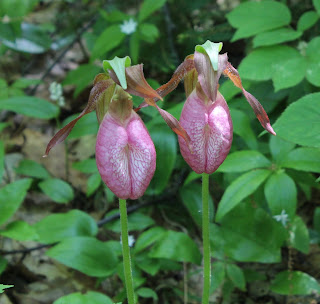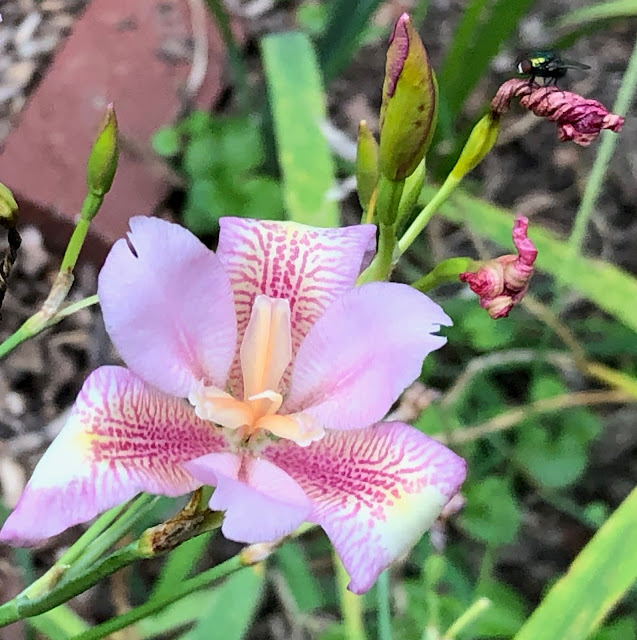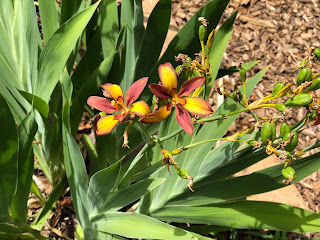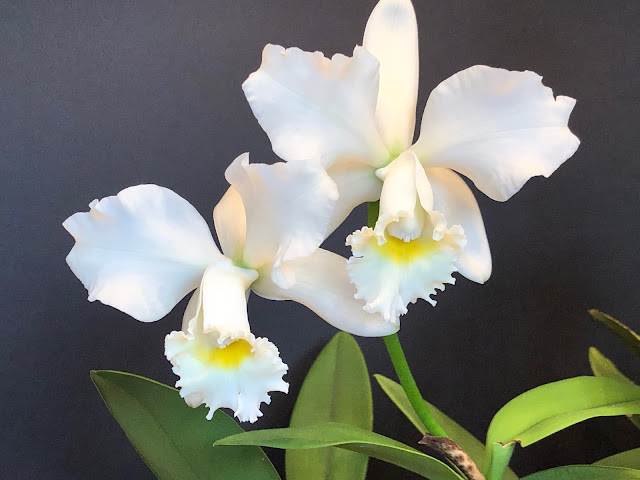January
2020
A New Year
We wish all of you a Happy New Year.
We wish all of you a Better new year.
I finished a major project at work last week. It was intense since that was the only matter on my calendar. I worked on it every day, for most of the day.
I did mostly take New Year's day off.
That was a glorious day. It was sunny and above freezing. I was able to do some yard work. Again. How am I able to do yard work this time of year?
I also just played with my pictures.
I got a black piece of poster board, and set up a little picture studio.
You can see the results in the Right Now section.
But speaking of the outside let me show you a picture I took yesterday.
This is not the same snowdrop clump I have shown you the last few weeks (if 2 plants can be a clump).

Here is a closeup.
Yes, indeed that is a bud.
The forecast for this week is for more days in the 40's and another one in the 50's. We should have a real snowdrop flower by the end of the week.
(For those of you who come by the yard this pair is besides the star magnolia on the south east corner of the house.)

Last Week in the contest
What a contestFor the Tree Peony picture to finish fourth certainly says something.
Near the end of the week I thought we were going to have a three way tie.
Here was your winner, by a single vote.
Every vote counts.

The full vote was:
Little Black Iris 11
White Tree Peony 9
Night Blooming Cereus 11
Snowdrops 2
Red Peony 12
By the way, you can see the full vote over there on the right. If you scroll down from this week's poll you will find the previous weeks' numbers.
Here are the contestants for Week 6
#1 Cypripedium Gisela
(May 22, 2019)
(May 22, 2019)

This is a Cypripedium orchid. It is the one orchid I have that grows in the ground. Outside. Despite the cold. They are called the Slipper orchids. They have also been called Lady Slippers, moccasin flower or the best name, squirrel foot. (What?)
I have had this plant for maybe 10 years. For the longest time there were just 2-3 flowers. In 2009 I think there were 9.
When I think about the coming Spring I can really look forward to seeing this colony emerge.
Cypripedium is the genus. There are 56 species. The plant is a hybrid. It is a cross between two species. Those are C. macranthos and C. parviflorum.
C. parviflorum is the wildflower found in North America.
Here is the Forrest Service link to that species.
https://www.fs.fed.us/wildflowers/beauty/cypripedium/cypripedium_parviflorum.shtml
Here is the wikipedia for Cyps as they are called.
https://en.wikipedia.org/wiki/Cypripedium
I must say there is no better outdoors experience than going on a walk and finding one of these slipper orchids. I remember 20 years ago going to Backbone State Park, here in Iowa, and finding a nice clump of the yellow slippers right near the path.
We also were in Maine a few years ago, right at the time the pink ones were blooming.
The Coastal Maine Botanical Gardens, which is really nice, is home to many.
Here is the link to that garden.
https://www.mainegardens.org/
If you are in the neighborhood try to discover this great garden.
It is about an hour north of Portland, which
#2 Oriental Poppy- Beauty of Livermore
(June 2, 2019)

We saw this poppy in the front yard up the street about 30 years ago. We embarked on a quest to get one for the garden. But it was not labeled. We were looking for just that color of red.
So we tried to find it in the nurseries and the catalogues. It took years but we finally got a name, and then the plant.
It was called Beauty of Livermore.
The botanical name for Oriental poppies is Papaver orientale.
The Genus is papaver
The Species is orientale.
The opium poppy is P. somniferum.
That means it is in the same Genus as the Oriental poppy.
Here is the wikipedia about that opium poppy. It suggests that it is a misnomer to call somniferum the opium poppy.
https://en.wikipedia.org/wiki/Papaver_somniferum
Read about poppies here.
https://en.wikipedia.org/wiki/Poppy
The Oriental poppy plants die back in the summer.
This is a survival technique in Central Asia.
In my garden when they disappear I do have to remember not to plant something right on top of them.
They are listed as rabbit and more importantly deer resistant.
I can grow them but they would do better with more sun.
Beauty of Livermore grows in the front yard under the 100 year old elm tree.
It is high shade after the leaves come out.
#3 Black daylily
(July 20, 2019)

A really really black flower is amazing.
This is one of them.
There are several daylilies that are really black.
This is so black that the pollen actually messes up the picture sometimes.
I will give you a close up of the center of the picture, in the bonus section.
#4 Pardancanda lily
named Summer Candy
(August 15, 2019)
named Summer Candy
(August 15, 2019)

It is with some pleasure that I introduce a new flower to the contest. This is a hyridized pardancanda.
I got it in 2018 and it bloomed nicely in 2019.
More are available at the Joe Pye Weed Gardens in Massachusetts. I know of no other place where you can get hybridized flowers like this. Of course if you look at their webcite you should see their Siberian Iris. They are rather special too.
So what are pardancandas?
Are they related to Blackberry lilies or Candy lilies?
Are they Blackberry lilies or Candy lilies.
Here is Dave's Garden.
https://davesgarden.com/guides/articles/view/2866
They are so new to the plant world that there is no wikipedia page.
More information, with pictures is found here:
http://amycampion.com/candy-lilies-why-i-love-em-how-to-grow-em/
So the genus for pardancandas is "X Pardancanda".
The species is norrisii.
I think the X before the name of the genus means that the genus is a cross.
The person who did the crossing was Mr. Norriss.
The genus is a cross between Belamcanda chinensis and Pardanthopsis dichotoma.
Imagine that.
Well the first one of those is the blackberry lily.
So the pardancanda lily is ofter shortened to candy lily.
To add to the confusion they are called lilies but are really iris.
I do believe that. The first spring after I grew them the previous year, I found all these little iris coming up. I had not planted them there. Well it was the seedlings coming up.
The seeds really are rather fertile.
I took some seeds from this special one. I will start those this winter.
I like these flowers in part because they bloom in August, after the riot of color has ended.
They also will surprise you as to just what color will be where.
#5 Annual delights
(August 24, 2019)
(August 24, 2019)

Sometimes there is a combination of plants that just works.
Here Persian Shields is combined with Campfire coleus.
By August they had grown all together and were about perfect.
They are both annuals. That means they are just for the one season.
It was such a good combination that I made cuttings of both.
I will have many starts for the new season that will be here sooner than you would imagine.
Vote away.
Get a second person at your house to vote.
Spread the word.
We will get through the big dark time.
Bonus pictures
Here is the original of this image. There is much more background.
I find the color of this flower, captured by this image, about the best color ever.
In this picture you get more contrast as you have more background, with its greens and browns.

Here are the two pictures, side by side.
What do you think?


Here are pictures of orchids from that trip to the Maine Coastal Botanical Gardens in 2017. My that seems a long time ago. In the slide show that follows there is a picture of Christopher when he was just 5 months old.




Here is a slide show of that Garden on our wonderful trip in 2017.
Down into the fiery pit.

Here is another picture of the pardancanda.

I almost used this picture. It is an enlargement of the picture right above this. It has the flower, the bud, and the wonderful rolled up flower after it has bloomed. It even has a bug.

Here are the other pardancandas in the garden. The all orange one was the first one I got. Then I got the one that is yellow. Then I got the purple and yellow one. Now they are crossing themselves. I am never sure who I will get.
On the other hand if I know where one color is, all the little starts around there will likely be close to that color.







Annuals
Here are my current cuttings from annuals from last fall. They cannot go outside until mid April at the earliest. So they will get bigger. But I will make cuttings from my cuttings. That is a way to get lots of plants.
Just what I need.


Right Now





This was not in the photo booth. But it was perhaps the best of the group.

Look at that center of the flower. There are those things that look like horns.



Julia's recipe
North African Meat balls

There are lots of ingredients, but nothing too exotic. As with all meatball recipes, the meatballs can be prepared and refrigerated ahead of time. Same for the sauce. That said, this recipe can come together in about an hour.
For the sauce: 2 tablespoons olive oil; 1-1/2 cups chopped onion; 2 teaspoons smushed garlic; 2 tablespoons tomato paste; a 1" piece of stick cinnamon; a big pinch of saffron if you have it; 3 cups chicken stock or bouillon; some salt and pepper
For the meatballs: about 1 lb. ground lamb (or ground beef); 1 cup white bread (not wonder bread, not whole wheat or rye or anything unusual), cut into 1/2" cubes; 1 cup milk; 1 egg; 1 tablespoon smushed garlic; 1-2 tablespoons of minced scallion or onion and a bunch of spices: 1/4 teaspoon black pepper; 1/8 teaspoon nutmeg; 1 teaspoon turmeric; 2 teaspoons paprika; 1/4 teaspoon cayenne; 1/4 teaspoon ground cloves; 1/4 teaspoon ground coriander; 1/2 teaspoon ground cumin plus 1 teaspoon of kosher salt. And a bit of white flour to dust the meatballs with.
The recipe calls for 3 tablespoons each of minced parsley and cilantro in the meatballs. These are controversial herbs in my home, and I have never been able to mince them to be small enough to suit me. So I left them out, without any ill consequences.

I started by making the sauce. I heated the olive oil in a big non-stick skillet and cooked the onion, over medium heat. After a couple of minutes, I added the smushed garlic and continued to cook.

When the onions were soft, I added the tomato paste and stirred it in, along with the piece of stick cinnamon and about !/2 teaspoon of salt and 1/4 teaspoon of pepper and the saffron. I cannot tell you that I noticed the saffron in the finished dish. If you have it, use it. If you don't, don't worry about it.

Next I added 3 cups of chicken stock and let the mixture come to a simmer. I let it cook for about 10 minutes, and then moved it to a back burner to await further developments.
While the sauce was simmering, I poured the milk into the bowl with the bread cubes. I let that sit for 5 minutes and then wrung out the bread, discarded the milk and put the bread into a biggish bowl.

Next up, the meatballs. I added all of the meatball ingredients to the bowl with the wrung-out bread: the lamb, garlic, finely chopped scallion, egg and all the spices plus the salt.
Here is the bowl full of meatball makings. Next I rolled up my sleeves and mixed it up with my hands. No other tool really works.
Overmixing is fine for meatballs (although not for hamburger patties - I don't know why).
When the meatball mixture was thoroughly mixed, I used my smallest scoop (about 1 tablespoon) to portion out the stuff. I ended up with I think 36 or 38 meatballs, which I put on 2 silpat-lined rimmed baking sheets. I turned the oven on to 350 degrees.

I rolled the meatball portions into balls and then I rolled the balls in flour to coat lightly. I put the pans in the oven for about 15 minutes. After 7 minutes, I took the pans out and turned the meatballs over so they would brown on the other side. And I rotated the pans as well, top to bottom, bottom to top; front to back, back to front. Then I baked them for another 8 minutes.

Here are the meatballs fresh from the oven. The NYT wanted me to fry the meatballs for 4 minutes, on high heat, in 1/4" of oil. I did not want to do that. Pan roasting worked fine and I found it less spattery and nerve-wracking than frying.

When all the meatballs were done, I transferred them all to the big skillet with the saffron-tomato sauce, having taken out the piece of stick cinnamon.

I cooked the meatballs in the sauce for 20 minutes on just enough heat to maintain a simmer, covered.
The flour in which the meatballs had been rolled thickened the sauce during the 20 minute simmering time.
If you are gluten-free, use some other flour - potato starch, rice flour, tapioca flour - to have the same effect.

And here they are - meatballs with North African spices in tomato sauce.
The NYT suggested serving the meatballs with Israeli cous cous (that's the cous cous that looks like fish-eye pasta). And we took their advice: I cooked 1 cup of big cous cous in water (like the pasta that it is). While it was cooking, I plumped 1/2 cup of golden raisins in 1 cup of hot water. (Feel free to use regular raisins or some other small dried berry or fruit). Then I drained the pasta, put it in a serving bowl and stirred in the drained raisins, 2 tablespoons of butter and 1/2 teaspoon of cinnamon. Philip was skeptical about the raisins, but said the whole thing was delicious. And it was.
We are not capable of polishing off that many meatballs at once, so we froze 18 of them (with some of the sauce). They freeze and reheat just fine, for supper on a day when you can't think and don't have time.
Odds and End
Snowdrop update
Here is the clump I have shown you several times in the last few weeks. The buds are starting to show at the tips of the plants.

Deer path
Iowa City completed his deer hunt.
I still seem to have a deer path through the back yard.
When they step on the ground that is not frozen they do make an impression.
Oh well.
Dates to remember
February 21, 2020 The first spring training baseball game happens.
Be safe.
Philip
3 comments:
I wish I'd had three votes. I liked the poppy, the autumn foliage, and the candy lily, and in the end chose the candy lily, thus (I now see) putting it in the lead.
Since you asked, I liked the larger shot of the poppy better than the close-up. I like seeing a flower in situ. Colors that really POP look more impressive against their surroundings, in my opinion. Shy flowers, on the other hand, look great in close-ups. But really, flower photos by a good photographer (like you) always look terrific.
My, that recipe looks tasty!
Pat
Maybe I could introduce rank ordered voting.
I chose the poppy because of the color, and the crepe paper texture.
I expected you would like the green background for the poppy, from your previous comments.
I am playing with editing pictures. It is better than TV, and keeps me awake.
With effort I can make the background black.
I will show you the effect with the poppy picture this coming week.
I will try it with a shy flower and see how it works.
I do appreciate the comments.
The pictures were particularly beautiful in this post Phil. Your new "photo booth" makes for spectacular pics!
Post a Comment